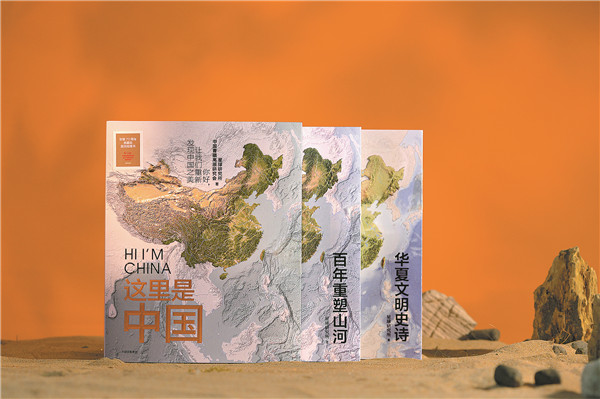
Published by Citic Press Group in September, Hi I'm China (Volume 3) integrates archaeological discoveries, stunning pictures and professional maps to provide a panoramic view of the country's past and present. It is the third book of the Hi I'm China series by Institute for Planets. [Photo provided to China Daily]
Book series offers readers a panoramic view of the country while leveraging social media to bring more knowledge to the public, Wang Qian reports.
As one of the oldest civilizations in the world, China has successfully maintained a persistent unity pattern. A recently published book Hi I'm China (Volume 3) integrates archaeological discoveries, stunning pictures and professional maps to provide a panoramic view of the country's past and present.
"In this book, you can see the most imaginative creations that came from Chinese civilization. The structures built by our ancestors still standing today are worth discovering, exploring and recording," Geng Huajun, head of the Institute for Planets behind publication of the book, says.
It is the third volume of the Hi I'm China series by Citic Press Group, with Geng planning the fourth and fifth books, introducing the country's geological evolution dating back 65 million years and the wildlife inhabiting it.
For Geng, the book is his latest effort to let more people know about the splendor of China and what we can learn from its beauty.
Divided into four chapters — Origin, Growth, Interaction and Creation — Hi I'm China (Volume 3) took Geng and his team three years to select the cultural legacies that give a glimpse into the country's more than 5,000-year-old civilization.
According to the third national census of cultural relics conducted from 2007 to 2011, 766,722 immovable cultural heritage sites were identified. Authorities have placed 8,155 ancient villages under State protection.
"These numerous wonders, including the Great Wall and the Grand Canal, are testimony to how Chinese people created our civilization, which helps form today's China. The book explores how civilization has defined us," Geng writes in the book's foreword.
To capture the complexity of the vast and populous country, the book is richly illustrated with 421 photos and 75 infographic charts.

Published by Citic Press Group in September, Hi I'm China (Volume 3) integrates archaeological discoveries, stunning pictures and professional maps to provide a panoramic view of the country's past and present. It is the third book of the Hi I'm China series by Institute for Planets. [Photo provided to China Daily]
Thanks to the country's comprehensive research program tracing the origins of Chinese civilization, Geng admits that the program's fruitful achievements have made the book possible. The program, launched in 2002, has led to the excavations and studies of key sites, which have revealed a host of secrets about ancient China, including how early civilizations were formed and merged to create united diversity.
"Only based on these archaeological research results can we interpret the academic content into reader-friendly stories," Geng says.
Chen Xingcan, head of the Institute of Archaeology at the Chinese Academy of Social Sciences, speaks highly of the book: "It tells the story of the origin, growth, interactive communication and continuous creative process of Chinese civilization. The team has put in a lot of effort, producing a wonderful account of the cultural evolution and providing readers with ample room for imagination."
On the book review site Douban, the book scored 9.4 points out of 10. A Douban user named Wasi from Beijing comments that the book is like a museum on paper, unlocking the development of Chinese civilization. "Our ancestors built countless cities, some of which have long vanished, some leaving only ruins, and some enduring wind and rain to this day. Their existence allows us to travel through hundreds or even thousands of years."
In the Origin chapter, the book introduces the Archaeological Ruins of Liangzhu City, a UNESCO World Heritage Site that dates back 4,300 to 5,300 years in Hangzhou, East China's Zhejiang province; the massive Erlitou Site in Luoyang, Central China's Henan province, widely believed to be a late capital of the Xia Dynasty (c. 21st century-16th century BC); and the Sanxingdui Site in Guanghan, Southwest China's Sichuan province, which dates over 3,000 years ago.
There are also regrets in the topic selection, Geng says, adding that they wanted to write a story about the 4,300-year-old Taosi relics site in Linfen city, North China's Shanxi province, but the idea was abandoned because it lacked an interesting angle.

Published by Citic Press Group in September, Hi I'm China (Volume 3) integrates archaeological discoveries, stunning pictures and professional maps to provide a panoramic view of the country's past and present. It is the third book of the Hi I'm China series by Institute for Planets. [Photo provided to China Daily]
A social media account to popularize geographical and cultural knowledge was set up in 2016 by the Institute for Planets. It has more than 3.2 million followers on the video platform Bilibili and its 147 videos have garnered 8.8 million likes.
As its founder, Geng, a geography lover, knows how difficult it is for the account to grow from just himself to a team of over 100 members.
A graduate of Peking University's School of Journalism and Communication and working as an editor at the China Social Sciences Press, Geng discovered his interest in geography on campus when he read the magazine National Geographic.
Sensitive to words and noticing the popularity of smartphones, Geng decided to become a full-time blogger in 2016, opening the Institute for Planets official account on WeChat.
"At that time, I found the content about geography to be too academic and unsuitable for general readers. I wanted to build a geography platform that is both in-depth and suitable to popularize the topic," Geng says.
It didn't take long for Geng to publish his first hit article. In November 2016, the article What Would You See If You Made Your Way to Qomolangma's Summit? went viral online, which was read more than 4 million times and earned his account almost 60,000 followers. Before that, the account only had a few thousand subscribers.

Published by Citic Press Group in September, Hi I'm China (Volume 3) integrates archaeological discoveries, stunning pictures and professional maps to provide a panoramic view of the country's past and present. It is the third book of the Hi I'm China series by Institute for Planets. [Photo provided to China Daily]
Without introducing boring facts about the mountain, Geng shifts the perspective, telling of the natural scenery at different heights and the change in difficulties and mindsets of climbers as the altitude increases.
"It gave me the confidence to focus on that sector," Geng says.
In 2019, the Institute for Planets published its first book Hi I'm China (Volume 1) to interpret China from broad geographic perspectives and grand time scales. In 2021, it published the series' second volume to introduce the country's rapid development over the past 100 years.
"What is China? It is a simple question but not easy to answer. We have been trying to give our answer from a geological perspective and the book series is our perspective," Geng says.
No longer limited to text and images, the Institute for Planets uses diverse media, such as documentaries, to better present geological knowledge. Geng hopes they can produce outstanding documentaries similar to the BBC's productions.
Geng sets a grand vision for the account to take its viewers to see all the mountains, rivers and cities across the country.

Geng Huajun, head of the Institute for Planets, which develops the book series. [Photo provided to China Daily]